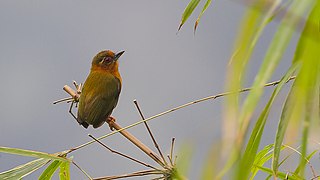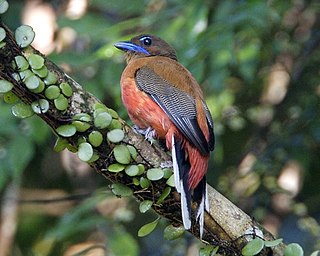
The Malabar trogon is a species of bird in the trogon family. It is found in the forests of India and Sri Lanka. In India it is mainly found in the Western Ghats, hill forests of central India and in parts of the Eastern Ghats. They are insectivorous and although not migratory, may move seasonally in response to rain in hill forest regions. Like in other trogons, males and females vary in plumage. The birds utter low guttural calls that can be heard only at close quarters and the birds perch still on a branch under the forest canopy, often facing away from the viewer making them easy to miss despite their colourful plumage.

The long-tailed broadbill is a species of bird that is found in the Himalayas, extending east through Northeastern India to Southeast Asia. It is the only bird in the genus Psarisomus. The long-tailed broadbill is about 25 cm (10 inches) in length and weighs between 50 and 60 grams. It can be identified by its shrill call.

The Eastern Himalayan broadleaf forests is a temperate broadleaf forest ecoregion found in the middle elevations of the eastern Himalayas, including parts of Nepal, India, Bhutan, Myanmar and China. These forests have an outstanding richness of wildlife.

The brown bullfinch is a species of bird in the true finch family, Fringillidae. It is found in Bhutan, China, India, Malaysia, Myanmar, Nepal, Pakistan, Taiwan, and Vietnam. Its natural habitats are temperate forests and subtropical or tropical moist montane forests.

The yellow-bellied warbler is a species of bush warbler. It was formerly included in the "Old World warbler" assemblage.

The yellow-bellied flowerpecker is a species of bird in the flowerpecker family Dicaeidae.

Ward's flycatcher, also known as Ward's flycatcher-vanga, is a species of bird in the family Vangidae. It is monotypic within the genus Pseudobias. It is endemic to Madagascar. Its natural habitat is subtropical or tropical moist lowland forests.

The white-browed piculet is a species of bird in the family Picidae. It is found in Bangladesh, Bhutan, Cambodia, India, Laos, Myanmar, Nepal, Thailand, and Vietnam. Its natural habitats are temperate forests and subtropical or tropical moist montane forests.

The Javan trogon is a species of bird in the family Trogonidae. The species was once lumped together with the Sumatran trogon in a single species, the blue-tailed trogon, but differences in size, weight, and plumage have led to the two being split. These two species were once lumped with the rest of the Asian trogons in the genus Harpactes, but have been split into their genus due to differences in plumage.

The Philippine trogon is a species of bird in the family Trogonidae. Primarily due to its plumage and colors, the bird has been associated with the mythical Ibong Adarna from Filipino epic poems. It is endemic to the Philippines.

Diard's trogon is a species of bird in the family Trogonidae. It is found in Brunei, Indonesia, Malaysia, Singapore, and Thailand. Its natural habitat is subtropical or tropical moist lowland forests. It is threatened by habitat loss.

The scarlet-rumped trogon is a species of bird in the family Trogonidae. It is found in Brunei, Indonesia, Malaysia, Myanmar, and Thailand. Its natural habitats are subtropical or tropical moist lowland forest, subtropical or tropical swamps, and subtropical or tropical moist montane forest. It is threatened by habitat loss.

The red-headed trogon is a species of bird in the family Trogonidae.

The red-naped trogon is a species of bird in the family Trogonidae. It is found in Brunei, Indonesia, Malaysia, and Thailand. Its natural habitat is subtropical or tropical moist lowland forests. It is threatened by habitat loss.

The orange-breasted trogon is a species of bird in the family Trogonidae. It is a colorful, sedentary species that inhabits the lower canopy of the lowlands and forest of southern China, southeast Asia, Borneo, Sumatra and Java.

The cinnamon-rumped trogon is a species of bird in the family Trogonidae or Trogons which are some of the most colourful birds on Earth especially the quetzals found in the Neotropics. There is very little known about this family of birds as a whole and even less information on the cinnamon-rumped trogon.

Whitehead's trogon is a species of bird in the family Trogonidae. It is endemic to the island of Borneo, where it is an uncommon resident in primary mountain forest. One of Borneo's largest trogons at 29 to 33 cm long, it is sexually dimorphic. The male is crimson on the head, nape, and underparts, with a black throat and grey chest; the rest of his upperparts are cinnamon-coloured. The female is similarly patterned, but cinnamon-brown where the male is scarlet. The species was first described for science by Richard Bowdler Sharpe in 1888, who named it for British explorer and collector John Whitehead. There are no subspecies.

The white-tipped quetzal is a species of bird in the family Trogonidae found in Venezuela, Colombia, and Guyana. Two subspecies have been described. Pharomachrus fulgidus fulgidus is found in the mountains of northern Venezuela and Pharomachrus fulgidus festatus ranges through the Santa Marta mountains of northeast Colombia. Quetzals are iridescent and colourful birds found in forests, woodlands and humid highlands. The white-tipped quetzal has been a limited subject of research. Pharomachrus nests have been studied to analyse the effects of rainfall on breeding, however conclusions are based on single observations. On the IUCN Red list of threatened species, the white-tipped quetzal is listed as a species of least concern.

The Hispaniolan trogon, also known as cacos is a species of bird in the family Trogonidae. It is endemic to Hispaniola in the Caribbean. It is one of the only two trogon species found in the Caribbean. It is the national bird of Haiti.

The Eastern Himalayan subalpine conifer forests is a temperate coniferous forests ecoregion which is found in the middle and upper elevations of the eastern Middle Himalayas, in western Nepal, Bhutan, northern Indian states including Arunachal Pradesh and Sikkim and adjacent Myanmar and China.





















